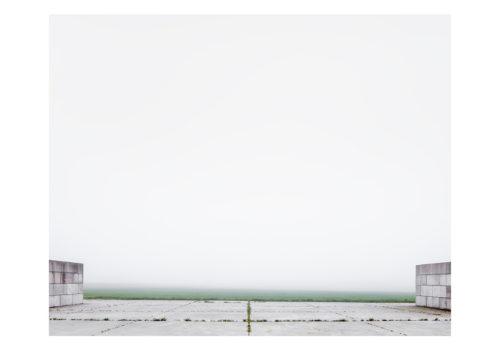Cultuurcentrum De Steiger Menen presents an exhibition by Paul D’Haese, Borderline.
In April 1935, the New York gallery owner, Julien Levy, brought together the pictures of Henri Cartier-Bresson, Manuel Alvarez Bravo and Walker Evans in a show under the title of Anti-graphic photographs. As the title of their exhibition suggests, these three young artists shared the same rejection of photography as “graphic art”, which was very much in vogue at the time. Instead of this aesthetic concept, they preferred a practice that was in direct contact with reality, because it was important to them, above all, to provide an interpretation of the world as they saw it.
Almost a century later, this work by Paul D’Haese, observing the French coastline, could just as easily claim to be “anti-picturesque”. Indeed, the shots taken between Bray-Dunes and Le Havre constitute the perfect counterexample of landscapes worthy of being painted for their agreed beauty. Unlike depictions of idyllic nature, they persistently show us details of the triviality of the coastal regions that have been fundamentally transformed by modern life.
In this sense, they prolong in their own way the advances made by the New Topographics: Photographs of a Man-Altered Landscape exhibition held at George Eastman House in Rochester in 1975. An exhibition-manifesto that consummated the break, begun by Walker Evans in the 1930s, away from the aesthetics of the sublime that had been the domain of American landscape painters since the 19th century. As commissioner William Jenkins said of the photographs by Robert Adams, Stephen Shore, Lewis Baltz and Ed Ruscha, these views are “stripped of all artistic artifice, reduced to the state of simple topographical documents, rich in visual information…”. Above all, they seem to make the very disappearance of the natural environment their subject.
Although not especially forthcoming about his work, Paul D’Haese likes to compare it with the work of a sculptor. The few models produced by him and given a wider audience in this book, bear witness here to this quest for the third dimension. The spatial depth suggested in this way is perfectly consistent – and this should be emphasised – with the images that question the forms of a heterogeneous building, the sediment of human activity. In particular it offers a beautiful metaphor for an approach that invites in-depth reading rather than surface contemplation. A critical reading set out by the title Borderline, a term that denotes being “on the edge” or “at the limit”.
The edge of the coastline, of course, but also the limit between what has meaning and what does not seem to have any. This is how the great panorama of the coastal strip, unrolled here, is gradually revealed, from image to image, like a grey area of reason. As the series progresses, everything seems increasingly quirky, poorly arranged, tinkered with, as if inspired by a paranoid town-planner. In this border region, traditionally an area of great migration, no one is to be seen, as if the inhabitants are all holed up in their homes for fear of a migratory surge to come. Very often, buildings with bricked up windows, or at least with the shutters closed, take on the appearance of blockhouses of more sinister memory. The cliffs, parapets, walls and fences complete the picture – if we dare say it – of the unfolding of France, as well as Europe, at a time of great planetary upheavals.
We are no longer in those carefree times that inspired Jacques Tati to make Les vacances de Mr Hulot. Taken along the same oceanfront as the enchanting location for this film, the photographs of Paul D’Haese reflect an atmosphere that is no longer the confident and cheerful one of the post-war period, but rather one of a fearful withdrawal. They form a contemporary tale that points out with humour – of which much is needed under the circumstances – the absurd side of an era in which we tend increasingly to view this coastline as a new “Atlantic wall”. It is a masterful visual tale, which we hope is not a premonition, about the desert that a country that closes itself off can become.
Jean-Marc Bodson, August 2020
Paul D’Haese : Borderline
from January 14, 2023 to February 19, 2023
Cultuurcentrum De Steiger Menen
Rijselstraat 77, 8930 Menen, Belgium
https://www.ccdesteiger.be/
















